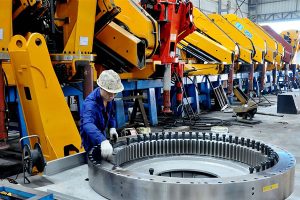5 ways to measure manufacturing equipment efficiency

Australia’s manufacturing industry is expanding steadily. Keeping tabs on the productivity and efficiency of equipment can help businesses maintain a competitive edge.
Australia’s manufacturing industry is worth $100 billion annually and accounts for 900,000 jobs. In spite of the demise of local automotive production last year, the sector continues to expand, with the Ai Group’s Australian Performance of Manufacturing Index (PMI) reaching a record high in March this year.
The 2017-18 financial year ended on a high note with 22 months of continuous growth for the sector, although the PMI eased from the March record of 63.1 to an even 52 in July – with indices over 50 indicating expansion.
For manufacturing business owners and plant operators, understanding and measuring the factors that influence manufacturing equipment efficiency can be a useful indicator of how to keep productivity up as the sector grows.
ExxonMobil is working to solve some of the industry’s biggest lubricant challenges. Here are five factors they recommend looking for when assessing the effectiveness and productivity of your equipment.
1. Availability
Put simply, a machine’s availability score measures how often a machine is available for use in production. When equipment availability is 100 per cent, it is always available during planned production times. Equipment availability is negatively affected by unplanned equipment downtime, material shortages and the time taken for machine changeover.
To calculate a machine’s availability score, divide the operating time by planned production time.
2. Performance
A machine’s performance score compares the number of units it produces per hour with the ideal production rate it would meet if it ran at its maximum rated speed at all times. So a score of 100 per cent means that the equipment is running as fast as possible. This is a useful benchmark to assess a machine’s speed loss.
The ideal cycle time is the time taken to produce one unit at rated speed, while the actual cycle time is the machine’s operating time divided by the number of units produced.
To work out the performance score for a machine, divide the ideal cycle time by the actual cycle time.
3. Quality
Another factor affecting productivity is material wastage and quality shortfalls. Rejected materials, factory seconds and products that need to be reworked after production can negatively affect a business’ productivity.
To measure the quality output for a piece of equipment, divide the number of good pieces produced during an operating cycle by the total unit output. For a defect-free production cycle, a machine will earn a quality score of 100 per cent.
4. Big losses
Most efficiency losses in manufacturing are caused by six subsets of equipment availability, performance and quality. These are:
- Planned downtime
- Breakdowns
- Minor stops
- Speed loss
- Production rejects
- Rejects on startup
Categorising incidents into these six subsets can help operators better understand the factors that are affecting plant efficiency.
5. Overall equipment effectiveness
Once you have determined a machine’s availability, performance and quality scores, you can calculate the overall equipment effectiveness (OEE).
To obtain the OEE for a piece of equipment, multiply its availability, quality and performance scores together. For an OEE of 100 per cent, a machine needs to be free of defective output, run at rated speed and have no unplanned outages.
While a single OEE score just indicates what a machine can do better, calculating OEE regularly and assessing trends for individual equipment and the plant as a whole can provide valuable insight into how to optimise productivity.
Target OEEs vary between plants and application categories, so it is important for owners and plant operators to determine the appropriate benchmark for their operations.
One size doesn’t fit all
Unfortunately there is no catch-all cure to fix productivity loss. This means that each business needs to consider how best to plan maintenance to optimise productivity according to their application, market and operating conditions.
One proactive approach to maintenance is considering whether the lubricants used in your operation provide the best protection for longer equipment life and reduced unplanned outages.
Taking advantage of the latest technology in oil analysis can also help plant operators keep tabs on the health of their system, and maintain productivity by diagnosing issues before they cause efficiency losses.
Equipment manufacturing sector key to tech innovation

China should make equipment manufacturing the “main arena” for the country’s technological innovation, Premier Li Keqiang said while presiding over a State Council executive meeting on June 17.
The Premier urged the Ministry of Science and Technology (MOST) and the Ministry of Industry and Information Technology (MIIT) to combine efforts to achieve this goal.
An official of MIIT attending the meeting requested further investment for technical upgrades, and the Premier said that it is the responsibility of enterprises to make such investments. The government’s input in this process should only act as a “catalyst”, with no injection of funds being wasted.
He then asked officials from MOST and MIIT to carry out feasibility studies to guide investment concerning technical upgrades.
“We are now pushing forward the ‘Made-in-China 2025’ plan,” the Premier said.
He also said that, as ministries like MOST and MIIT take advantage of the “historical opportunity” to upgrade the equipment manufacturing industry, they should initiate cutting-edge programs to make use of government funds allocated for this purpose.
The Premier added that they should promote technical upgrades in coordination with Chinese enterprises – which will lay a solid foundation for the long-term development of China’s science and technology sector.
Since the country launched its reform and opening-up policy most of the world’s consumer goods are made in China, Premier Li said, but the product brands – as well as the equipment to produce them – are usually from overseas.
He also said that, as the Chinese economy evolves, it will be difficult to maintain growth by “simply taking advantage of the cheap labor force”, but added that the country “enjoys enormous advantages in equipment manufacturing.”
And switching the focus of “made in China” from consumer goods to Chinese-made equipment will further upgrade the Chinese economy so that it can achieve the medium and high level of development.
During his visit to China Nuclear Power Engineering Co Ltd in Beijing on June 15, the Premier had the opportunity to increase his understanding of the domestically-developed third generation Hualong One Reactor.
During the meeting on June 17, the Premier said that without this domestically-developed reactor, developed countries would not seek equity participation in Chinese companies, and they would also not invite Chinese companies to buy into their enterprises.
“We should make the equipment manufacturing sector the main arena for the country’s technological innovation”, he told officials from MOST and MIIT.
The Premier stressed that the key to the “Made-in-China 2025” plan is to ensure that it is made by Chinese talents.
Absorbing the wisdom of others can help an individual to succeed, the Premier said.
As the government ignites mass entrepreneurship and innovation, the Chinese will come up with fresh ideas to unleash market vitality and promote the transformation of Made-in-China, he also said.
More information : Equipment manufacturing





